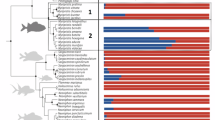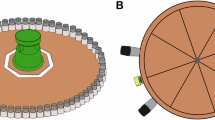Abstract
IN the course of experiments directed to another end, we have had occasion to determine the sensitivity at different stimulus frequencies of certain structures in the cricket (Gryllus domesticus) and the locust (Locusta migratoria migratorioides). These structures are (a) the long hair-sensilla on the cercus of the cricket, recently shown to subserve a partially acoustic function1, (b) the tympanal organ of the locust and (c) receptor organs which we believe to be identical with the short hair-sensilla generally distributed over the body of the locust.
This is a preview of subscription content, access via your institution
Access options
Subscribe to this journal
Receive 51 print issues and online access
$199.00 per year
only $3.90 per issue
Buy this article
- Purchase on SpringerLink
- Instant access to full article PDF
Prices may be subject to local taxes which are calculated during checkout
Similar content being viewed by others
References
R. J. Pumphrey and A. F. Rawdon-Smith, J. Physiol., 86 (1936). (Proc. Physiol. Soc., March 14, 1936.)
A. J. Derbyshire and H. Davis, Amer. J. Physiol, 118, 2, 476 (1935).
R. L. Wegel, Ann. Otol., 41, 770 (1932).
E. G. Wever, J. Comp. Psychol., 20, 17 (1935).
Author information
Authors and Affiliations
Rights and permissions
About this article
Cite this article
PUMPHREY, R., RAWDON-SMITH, A. Sensitivity of Insects to Sound. Nature 137, 990 (1936). https://doi.org/10.1038/137990a0
Issue date:
DOI: https://doi.org/10.1038/137990a0
This article is cited by
-
Neurophysiology goes wild: from exploring sensory coding in sound proof rooms to natural environments
Journal of Comparative Physiology A (2021)
-
The cercus-to-giant interneuron system in the bushcricketTettigonia cantans: Morphology and response to low-frequency sound
Journal of Comparative Physiology ? A (1983)
-
Reception of particle oscillation in a medium ? an unorthodox sensory capacity
Naturwissenschaften (1979)
-
Untersuchungen �ber den Aufbau und die Entstehung der Ges�nge einiger Feldheuschreckenarten und den Einfluss von Lautzeichen auf das Akustische Verhalten
Zeitschrift f�r Vergleichende Physiologie (1957)
-
Elektrophysiologische Untersuchungen von Chemo- und Mechanorezeptoren der Antenne des Seidenspinners Bombyx mori L.
Zeitschrift f�r Vergleichende Physiologie (1957)



